2023 CADILLAC LYRIC weight
[x] Cancel search: weightPage 203 of 424
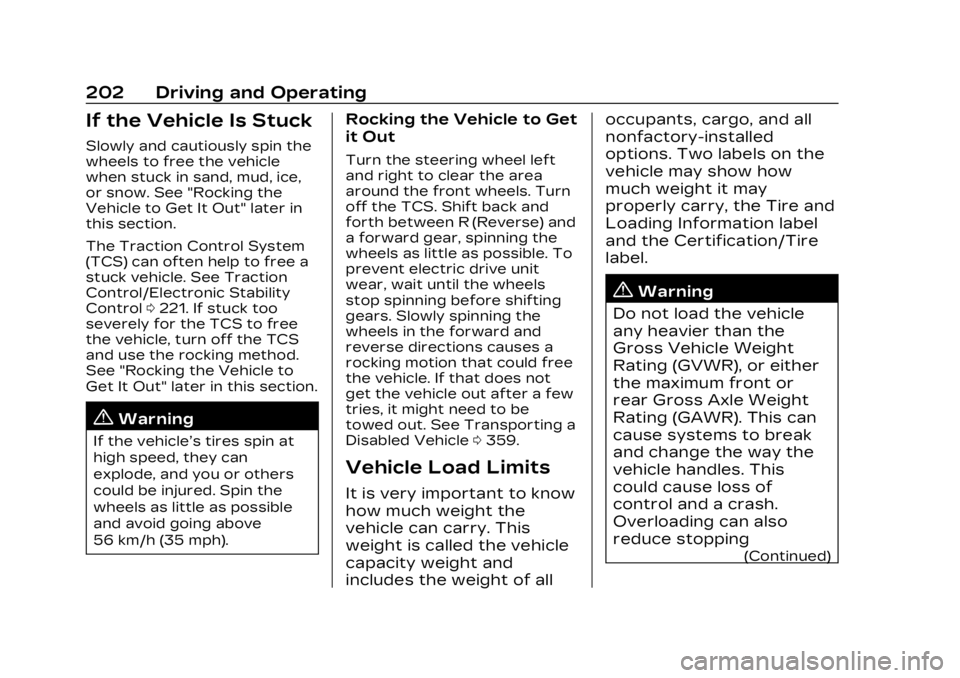
Cadillac Lyriq Owner Manual (GMNA-Localizing-U.S./Canada-15644413) -
2023 - CRC - 2/23/22
202 Driving and Operating
If the Vehicle Is Stuck
Slowly and cautiously spin the
wheels to free the vehicle
when stuck in sand, mud, ice,
or snow. See "Rocking the
Vehicle to Get It Out" later in
this section.
The Traction Control System
(TCS) can often help to free a
stuck vehicle. See Traction
Control/Electronic Stability
Control0221. If stuck too
severely for the TCS to free
the vehicle, turn off the TCS
and use the rocking method.
See "Rocking the Vehicle to
Get It Out" later in this section.
{Warning
If the vehicle’s tires spin at
high speed, they can
explode, and you or others
could be injured. Spin the
wheels as little as possible
and avoid going above
56 km/h (35 mph).
Rocking the Vehicle to Get
it Out
Turn the steering wheel left
and right to clear the area
around the front wheels. Turn
off the TCS. Shift back and
forth between R (Reverse) and
a forward gear, spinning the
wheels as little as possible. To
prevent electric drive unit
wear, wait until the wheels
stop spinning before shifting
gears. Slowly spinning the
wheels in the forward and
reverse directions causes a
rocking motion that could free
the vehicle. If that does not
get the vehicle out after a few
tries, it might need to be
towed out. See Transporting a
Disabled Vehicle 0359.
Vehicle Load Limits
It is very important to know
how much weight the
vehicle can carry. This
weight is called the vehicle
capacity weight and
includes the weight of all occupants, cargo, and all
nonfactory-installed
options. Two labels on the
vehicle may show how
much weight it may
properly carry, the Tire and
Loading Information label
and the Certification/Tire
label.
{Warning
Do not load the vehicle
any heavier than the
Gross Vehicle Weight
Rating (GVWR), or either
the maximum front or
rear Gross Axle Weight
Rating (GAWR). This can
cause systems to break
and change the way the
vehicle handles. This
could cause loss of
control and a crash.
Overloading can also
reduce stopping
(Continued)
Page 204 of 424

Cadillac Lyriq Owner Manual (GMNA-Localizing-U.S./Canada-15644413) -
2023 - CRC - 2/23/22
Driving and Operating 203
Warning (Continued)
performance, damage the
tires, and shorten the life
of the vehicle.
Tire and Loading Information
Label
Example Label
A vehicle-specific Tire and
Loading Information label is
attached to the center
pillar (B-pillar). The tire and
loading information label
shows the number of
occupant seatingpositions (1), and the
maximum vehicle capacity
weight (2) in kilograms and
pounds.
The Tire and Loading
Information label also
shows the size of the
original equipment tires (3)
and the recommended cold
tire inflation pressures (4).
For more information on
tires and inflation see Tires
0
334 and
Tire Pressure 0342.
There is also important
loading information on the
vehicle Certification/Tire
label. It may show the
Gross Vehicle Weight
Rating (GVWR) and the
Gross Axle Weight Rating
(GAWR) for the front and
rear axle. See
“Certification/Tire Label”
later in this section.
“Steps for Determining
Correct Load Limit– 1.
Locate the statement
"The combined weight of
occupants and cargo
should never exceed
XXX kg or XXX lbs." on
your vehicle’s placard.
2.Determine the combined
weight of the driver and
passengers that will be
riding in your vehicle.
3.Subtract the combined
weight of the driver and
passengers from XXX kg
or XXX lbs.
4.The resulting figure
equals the available
amount of cargo and
luggage load capacity.
For example, if the "XXX"
amount equals 1400 lbs.
and there will be five
150 lb passengers in your
vehicle, the amount of
available cargo and
Page 205 of 424
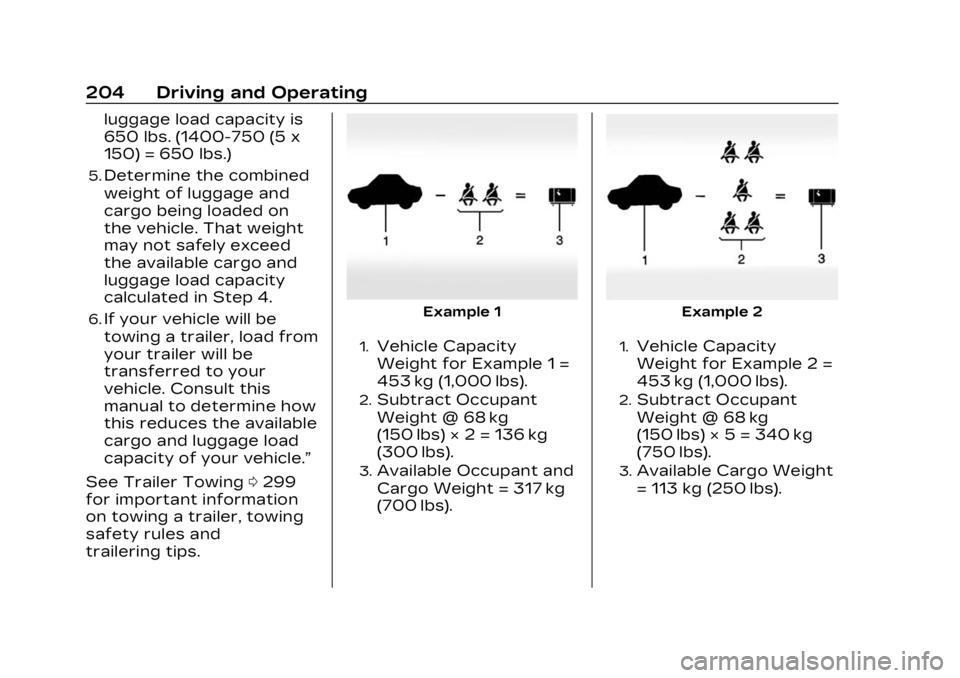
Cadillac Lyriq Owner Manual (GMNA-Localizing-U.S./Canada-15644413) -
2023 - CRC - 2/23/22
204 Driving and Operating
luggage load capacity is
650 lbs. (1400-750 (5 x
150) = 650 lbs.)
5.Determine the combined
weight of luggage and
cargo being loaded on
the vehicle. That weight
may not safely exceed
the available cargo and
luggage load capacity
calculated in Step 4.
6.If your vehicle will be
towing a trailer, load from
your trailer will be
transferred to your
vehicle. Consult this
manual to determine how
this reduces the available
cargo and luggage load
capacity of your vehicle.”
See Trailer Towing 0299
for important information
on towing a trailer, towing
safety rules and
trailering tips.Example 1
1.Vehicle Capacity
Weight for Example 1 =
453 kg (1,000 lbs).
2.Subtract Occupant
Weight @ 68 kg
(150 lbs) × 2 = 136 kg
(300 lbs).
3.Available Occupant and
Cargo Weight = 317 kg
(700 lbs).
Example 2
1.Vehicle Capacity
Weight for Example 2 =
453 kg (1,000 lbs).
2.Subtract Occupant
Weight @ 68 kg
(150 lbs) × 5 = 340 kg
(750 lbs).
3.Available Cargo Weight
= 113 kg (250 lbs).
Page 206 of 424

Cadillac Lyriq Owner Manual (GMNA-Localizing-U.S./Canada-15644413) -
2023 - CRC - 2/23/22
Driving and Operating 205
Example 3
1.Vehicle Capacity
Weight for Example 3 =
453 kg (1,000 lbs).
2.Subtract Occupant
Weight @ 91 kg
(200 lbs) × 5 = 453 kg
(1,000 lbs).
3.Available Cargo Weight
= 0 kg (0 lbs).
Refer to the vehicle's tire
and loading information
label for specific
information about the
vehicle's capacity weight and seating positions. The
combined weight of the
driver, passengers, and
cargo should never exceed
the vehicle's capacity
weight.
Certification/Tire Label
Label Example
A vehicle-specific
Certification/Tire label is
attached to the center
pillar (B-pillar).
The label may show the
size of the vehicle's original
tires and the inflationpressures needed to obtain
the gross weight capacity
of the vehicle. The label
shows the gross weight
capacity of the vehicle. This
is called the Gross Vehicle
Weight Rating (GVWR). The
GVWR includes the weight
of the vehicle, all
occupants, and cargo.
The Certification/Tire label
may also show the
maximum weights for the
front and rear axles, called
the Gross Axle Weight
Rating (GAWR). To find out
the actual loads on the
front and rear axles, weigh
the vehicle at a weigh
station. Your dealer can
help with this. Be sure to
spread the load equally on
both sides of the
centerline.
Page 207 of 424

Cadillac Lyriq Owner Manual (GMNA-Localizing-U.S./Canada-15644413) -
2023 - CRC - 2/23/22
206 Driving and Operating
Caution
Overloading the vehicle may
cause damage. Repairs
would not be covered by the
vehicle warranty. Do not
overload the vehicle.
{Warning
Things inside the vehicle
can strike and injure
people in a sudden stop
or turn, or in a crash.
.Put things in the cargo
area of the vehicle. In
the cargo area, put
them as far forward as
possible. Try to spread
the weight evenly.
.Never stack heavier
things, like suitcases,
inside the vehicle so
that some of them are
above the tops of the
seats.
(Continued)
Warning (Continued)
.Do not leave an
unsecured child
restraint in the vehicle.
.Secure loose items in
the vehicle.
.Do not leave a seat
folded down unless
needed.
Starting and
Operating
New Vehicle Break-In
Caution
Avoid making hard stops for
the first 322 km (200 mi).
During this time the new
brake linings are not yet
broken in. Hard stops with
new linings can mean
premature wear and earlier
replacement. Follow this
breaking-in guideline every (Continued)
Caution (Continued)
time you get new brake
linings. Following break-in,
vehicle speed and load can
be gradually increased.
Power Button
The vehicle has an electronic
pushbutton start.
The Remote Key must be in
the vehicle for the system to
operate. If the vehicle will not
start, place the Remote Key in
the transmitter pocket, inside
the center console.
Page 300 of 424
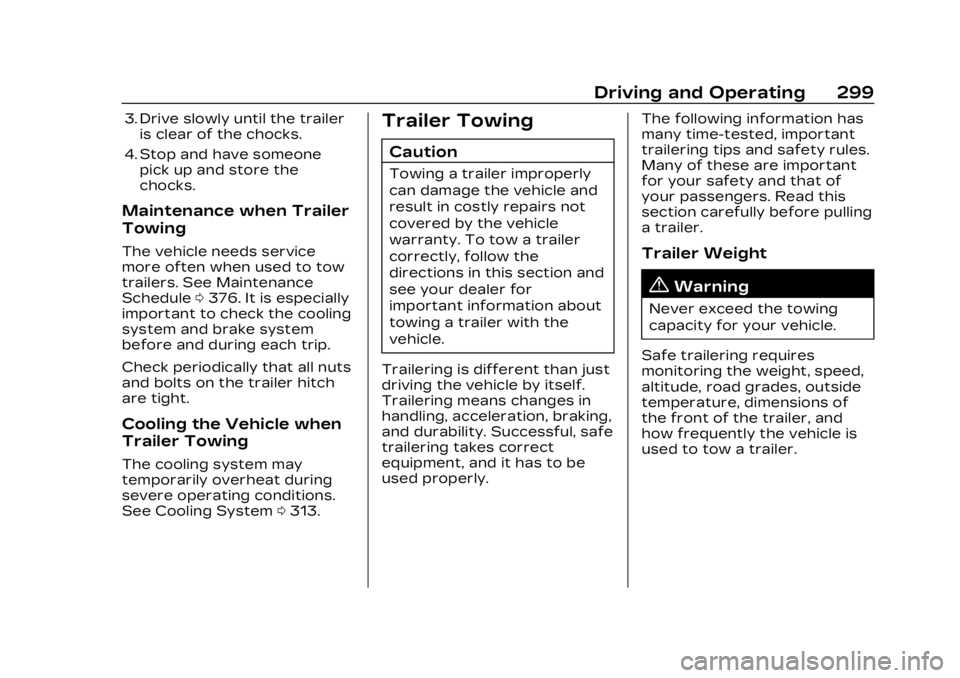
Cadillac Lyriq Owner Manual (GMNA-Localizing-U.S./Canada-15644413) -
2023 - CRC - 2/23/22
Driving and Operating 299
3. Drive slowly until the traileris clear of the chocks.
4. Stop and have someone pick up and store the
chocks.
Maintenance when Trailer
Towing
The vehicle needs service
more often when used to tow
trailers. See Maintenance
Schedule 0376. It is especially
important to check the cooling
system and brake system
before and during each trip.
Check periodically that all nuts
and bolts on the trailer hitch
are tight.
Cooling the Vehicle when
Trailer Towing
The cooling system may
temporarily overheat during
severe operating conditions.
See Cooling System 0313.
Trailer Towing
Caution
Towing a trailer improperly
can damage the vehicle and
result in costly repairs not
covered by the vehicle
warranty. To tow a trailer
correctly, follow the
directions in this section and
see your dealer for
important information about
towing a trailer with the
vehicle.
Trailering is different than just
driving the vehicle by itself.
Trailering means changes in
handling, acceleration, braking,
and durability. Successful, safe
trailering takes correct
equipment, and it has to be
used properly. The following information has
many time-tested, important
trailering tips and safety rules.
Many of these are important
for your safety and that of
your passengers. Read this
section carefully before pulling
a trailer.
Trailer Weight
{Warning
Never exceed the towing
capacity for your vehicle.
Safe trailering requires
monitoring the weight, speed,
altitude, road grades, outside
temperature, dimensions of
the front of the trailer, and
how frequently the vehicle is
used to tow a trailer.
Page 301 of 424
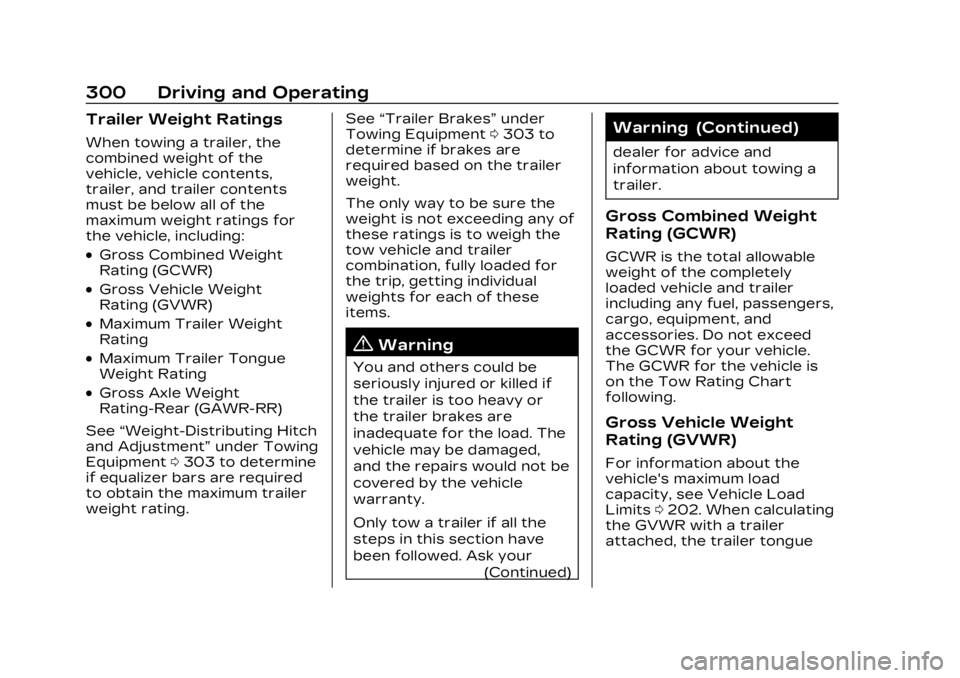
Cadillac Lyriq Owner Manual (GMNA-Localizing-U.S./Canada-15644413) -
2023 - CRC - 2/23/22
300 Driving and Operating
Trailer Weight Ratings
When towing a trailer, the
combined weight of the
vehicle, vehicle contents,
trailer, and trailer contents
must be below all of the
maximum weight ratings for
the vehicle, including:
.Gross Combined Weight
Rating (GCWR)
.Gross Vehicle Weight
Rating (GVWR)
.Maximum Trailer Weight
Rating
.Maximum Trailer Tongue
Weight Rating
.Gross Axle Weight
Rating-Rear (GAWR-RR)
See “Weight-Distributing Hitch
and Adjustment” under Towing
Equipment 0303 to determine
if equalizer bars are required
to obtain the maximum trailer
weight rating. See
“Trailer Brakes” under
Towing Equipment 0303 to
determine if brakes are
required based on the trailer
weight.
The only way to be sure the
weight is not exceeding any of
these ratings is to weigh the
tow vehicle and trailer
combination, fully loaded for
the trip, getting individual
weights for each of these
items.
{Warning
You and others could be
seriously injured or killed if
the trailer is too heavy or
the trailer brakes are
inadequate for the load. The
vehicle may be damaged,
and the repairs would not be
covered by the vehicle
warranty.
Only tow a trailer if all the
steps in this section have
been followed. Ask your
(Continued)
Warning (Continued)
dealer for advice and
information about towing a
trailer.
Gross Combined Weight
Rating (GCWR)
GCWR is the total allowable
weight of the completely
loaded vehicle and trailer
including any fuel, passengers,
cargo, equipment, and
accessories. Do not exceed
the GCWR for your vehicle.
The GCWR for the vehicle is
on the Tow Rating Chart
following.
Gross Vehicle Weight
Rating (GVWR)
For information about the
vehicle's maximum load
capacity, see Vehicle Load
Limits0202. When calculating
the GVWR with a trailer
attached, the trailer tongue
Page 302 of 424
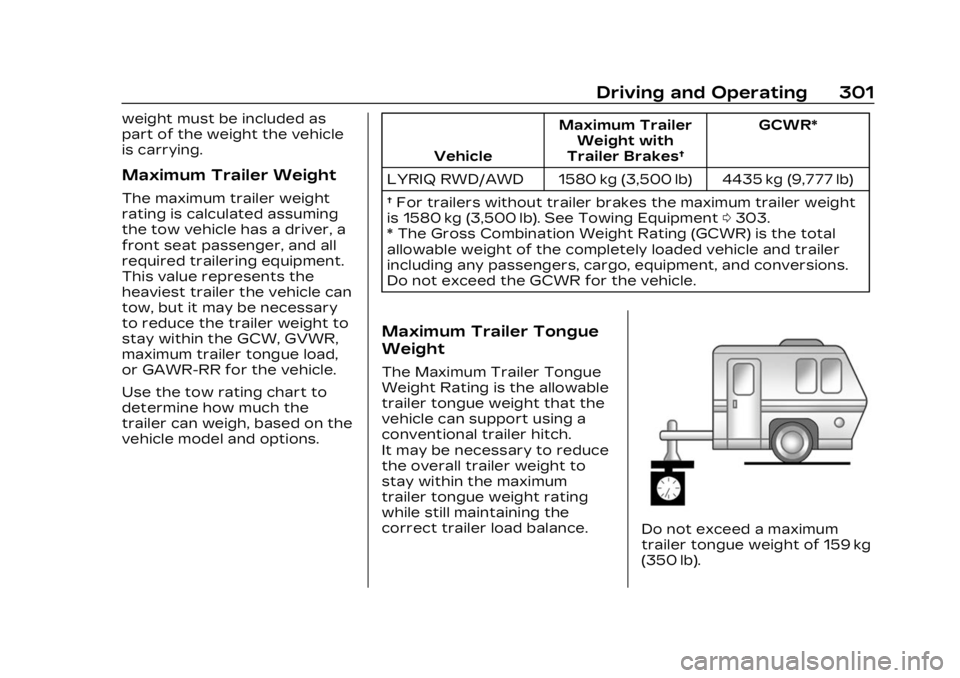
Cadillac Lyriq Owner Manual (GMNA-Localizing-U.S./Canada-15644413) -
2023 - CRC - 2/23/22
Driving and Operating 301
weight must be included as
part of the weight the vehicle
is carrying.
Maximum Trailer Weight
The maximum trailer weight
rating is calculated assuming
the tow vehicle has a driver, a
front seat passenger, and all
required trailering equipment.
This value represents the
heaviest trailer the vehicle can
tow, but it may be necessary
to reduce the trailer weight to
stay within the GCW, GVWR,
maximum trailer tongue load,
or GAWR-RR for the vehicle.
Use the tow rating chart to
determine how much the
trailer can weigh, based on the
vehicle model and options.Vehicle
Maximum Trailer
Weight with
Trailer Brakes† GCWR*
LYRIQ RWD/AWD 1580 kg (3,500 lb) 4435 kg (9,777 lb)
† For trailers without trailer brakes the maximum trailer weight
is 1580 kg (3,500 lb). See Towing Equipment 0303.
* The Gross Combination Weight Rating (GCWR) is the total
allowable weight of the completely loaded vehicle and trailer
including any passengers, cargo, equipment, and conversions.
Do not exceed the GCWR for the vehicle.
Maximum Trailer Tongue
Weight
The Maximum Trailer Tongue
Weight Rating is the allowable
trailer tongue weight that the
vehicle can support using a
conventional trailer hitch.
It may be necessary to reduce
the overall trailer weight to
stay within the maximum
trailer tongue weight rating
while still maintaining the
correct trailer load balance.
Do not exceed a maximum
trailer tongue weight of 159 kg
(350 lb).